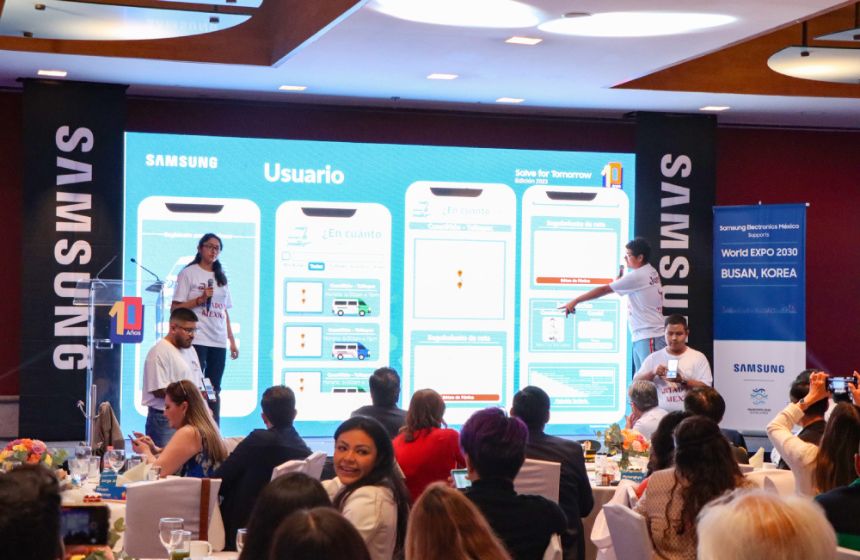You are in class or in a meeting and part of the group has not arrived because they had difficulties with public transportation. Or you are late for an appointment after waiting a long time for the bus. Do these scenes sound familiar to you? Young Jorge Cigarroa thought about these sequences while heading to a “brainstorming” meeting with his school group. What he did not imagine is that those thoughts would be the kick-off for an innovative project that earned his group first place in the 10th edition of Solve for Tomorrow Mexico.
“We were thinking about the social challenges of the city to use our knowledge on technology and create a project that offered a solution to society. But Jorge did not arrive,” explains Jesus Bañuelos, mediator teacher of the project ¿En cuánto llega? (“How long will it take?”, in English), from the College of Scientific and Technological Studies of the State of Mexico (CECyTEM Tultepec).
Jorge was the only graphic design student in a group with three programming students – two of the school’s technical professional education courses. “We were waiting for Jorge so we could get a complete idea of the challenges and opportunities. The students said that he was late because of the bus. So I told them that this was a problem we could solve,” recalls the teacher.
The project was carried out under the Innovation Department of CECyTEM Tultepec, where they recruit, through theoretical and practical exams, the best students to create solutions with social impact. The students involved are 17 and 18 years old and were in the last two years of technical education when the project was created (that is the last stage of compulsory schooling).
22 million people can benefit from the app
The Metropolitan Area of the Valley of Mexico where the school is located is the most populated metropolitan region in the country, with almost 22 million inhabitants. It is also the second most populated metropolitan region in America and the fourth in the world.
As in many similar places on the planet, public transportation users in this area face a constant risk of theft and insecurity on public roads as well as uncertainty, worry, constant delays, and ignorance about the status of the routes and their times. The students experienced the effects of this context, so they concluded that the most interesting thing would be to create an app so that anyone could track public transportation.
More accessible infrastructure to create an app
According to the educator, compiling a mobile application usually requires a lot of resources and powerful computers. “But, as we say in Mexico, there are many ways to skin a cat,” says the teacher. Which means, there are many ways to do something.
Bañuelos relates that while they were researching how to do this through the web with QR codes, (a barcode that can be scanned with mobile phones equipped with a camera), student Diego began looking for options and discovered an innovative technology called React Native: a library that uses JavaScript, used to develop applications for Android and iOS systems natively. With this new possibility, the dream of the app seemed closer.
Alliances to launch the project
In six months, with a lot of research and testing, the team managed to implement the app in its alpha version. But that was only possible with help. The director of CECyTEM supported the project from the beginning and the school’s programming and graphic design teachers made several recommendations. “We had talks with nearby universities, who helped us by showing us the possible paths to follow,” ads Bañuelos.
Based on the data provided by the Ministry of Mobility of the State of Mexico and the bus companies, the app presents detailed information on the arrival times of buses, combis or minibusses; their routes, vehicle identification data (even with images of each one), in addition to options for sharing trips and a “panic button”, capable of issuing alerts to the companies’ reporting system if the user feels unsafe at any time.
Empowered students
Bañuelos is happy about the effect this experience has had on the students. “We give them a route, but we must consider them equal… Some of them are already at another level. They are not just part of projects, they create projects themselves,” says the teacher.
The students are already multiplying their knowledge with younger classmates and, since they won first place in the Solve for Tomorrow, they have also been invited to events to share their experiences. “We thank Samsung for this terrific opportunity. It allowed us to continue growing as researchers and open the door to our student community for a mental change and, therefore, generate critical and more conscious people,” he concludes.

From school project to potential entrepreneur
When they started mentoring at Solve For Tomorrow, the first assignment they received was to take a social entrepreneurship certification. “That was something we had not thought about. The tutor says: if you have a more entrepreneurial vision, you are taking advantage of solving the problem and also being able to generate more development and more innovation,” says Bañuelos.
Apart from the financial support of the local transportation company, they had another idea to ensure the sustainability of the business. The application continues with a free version, with ads, but it also has a premium version, with a symbolic cost of 22 pesos (about 1.30 US dollars).
Now the team is in the legal procedures to patent the creation in Mexico. The expectation is to make an official launch to the public at the beginning of February 2024. “Afterwards the goal is to focus on more states of Mexico,” the teacherenvisions.
He believes the project can be replicated in other schools and communities. It is enough to have “trust and communication between us as educators and our authorities.”




